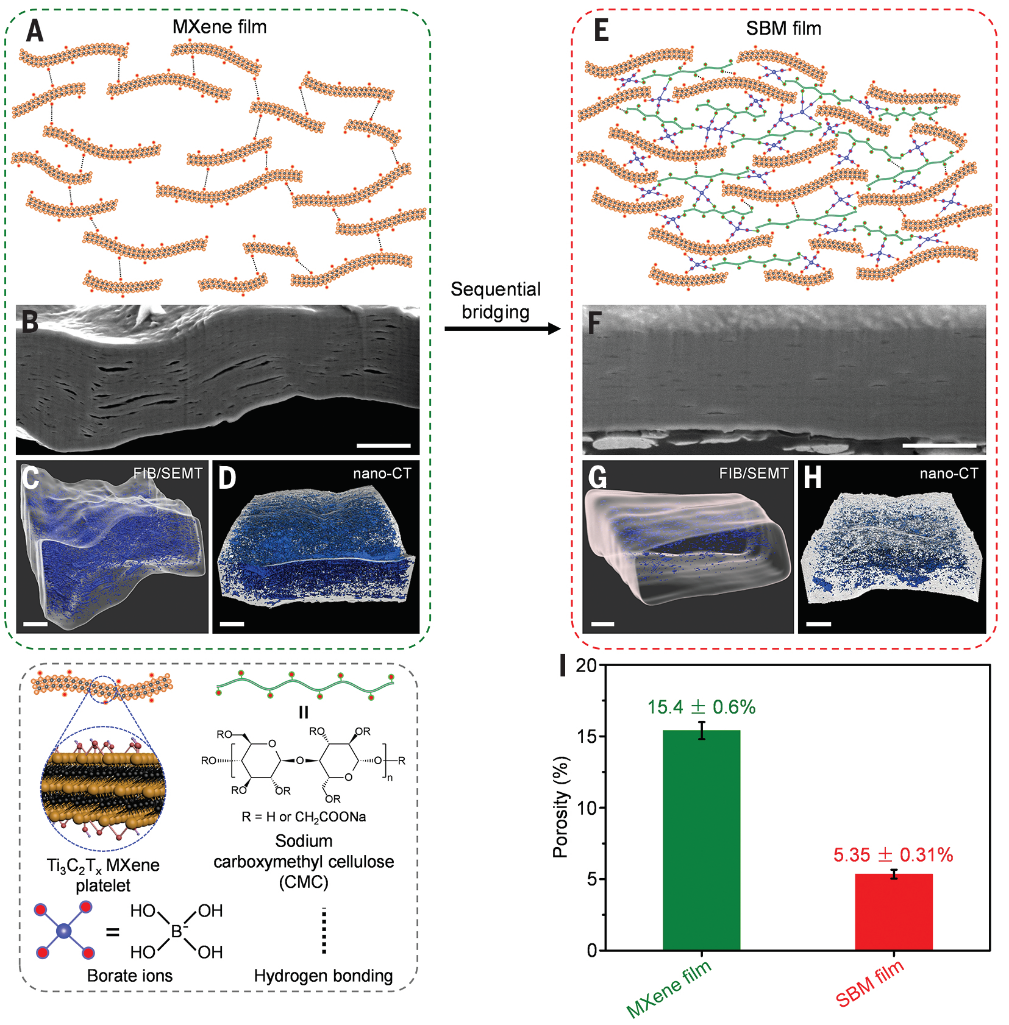On October 1, the latest findings of the research group led by Prof. Cheng Qunfeng from the School of Chemistry, titled “High-strength scalable MXene films through bridging-induced densification”, was published in Science . Wan Sijie, Li Xiang and Chen Ying are the first authors, and Prof. Cheng Qunfeng is the corresponding author.


Lightweight and high-strength polymer nanocomposites are important materials to solve the bottlenecks of miniaturization and lightweight in aerospace, and carbon fiber composites are now widely used in aerospace instead of metal materials to achieve weight reduction. When the number of voids existed in the material is reduced and national standards are met, carbon fiber composites can be safely applied in relevant fields.
Compared with carbon fiber, emerging two-dimensional nanomaterials such as graphenes and MXenes with better mechanical and electrical properties are the ideal materials for the production of lightweight and high-strength polymer nanocomposites. However, the number of voids increases during the process, resulting in polymer nanocomposites with performance far below the expectation. This problem has caused great difficulties in the basic and applied research and affected the development and applications of polymer nanocomposites.
In fact, the void deficiency is a common problem in polymer nanocomposites. Prof. Cheng Qunfeng’s Group has long been engaged in the basic research of polymer nanocomposites. They systematically characterized the three-dimensional void structure of titanium carbide MXene polymer composite films in the present work (Fig. 1A-D), which overturned the conventional perception of the tightly packed layer-by-layer structure of polymeric two-dimensional nanocomposites. Based on the previous work, they applied sequential bridging of hydrogen and covalent bonding agents to effectively remove the voids, resulting in highly compact MXene films.

Fig. 1 Structural characterization of SBM films. (A and E) Structural models of MXene (A) and SBM (E) films. (B and F) SEM images of cross-sections cut by an FIB for MXene (B) and SBM (F) films. (C and G) 3D-reconstructed void microstructure derived from FIB/SEMT for MXene (C) and SBM (G) films. Note that the serial section derived from FIB/SEMT is not perpendicular to the film surface. (D and H) 3D-reconstructed void microstructure derived from nano-CT for MXene (D) and SBM (H) films. Scale bars, 2 μm. (I) Porosities of MXene and SBM films derived from density measurements.
These films exhibit high tensile strength, in combination with high Young’s modulus, toughness, and resistance to sonication damage, cyclic mechanical deformation, oxidation, and stress relaxation (Fig. 2). Furthermore, they show excellent electrical conductivity and EMI shielding performance.

Fig. 2 Mechanical properties of SBM films. (A) Representative tensile stress–strain curves of MXene, CBM, HBM, and SBM films. (B) Comparison of the tensile strength, toughness, and electrical conductivity of SBM films (red line) with those of previously reported pure MXene films (blue lines) and MXene composite films (green lines). (C) Inclined-view SEM images of the fracture surfaces of MXene, CBM, HBM, and SBM films. Scale bars, 5 μm in low-resolution images and 1 μm in high-resolution images.
The group further produced sequentially bridged MXene (SBM) films (Fig. 3A-D). These highly oxidization-resistant, scalable SBM films with excellent mechanical properties have a greater potential than MXene films for use as shielding materials in portable and wearable electronic devices (Fig. 3E-F).

Fig. 3 Properties of large-area SBM films fabricated by DB casting and EMI SE of SBM films stored in humid air. (A) Photograph of SBM (DB) films. (B) SEM image of a cross-section of SBM (DB) films. Scale bar, 5 μm. (C) Representative tensile stress–strain curves of MXene (DB) and SBM (DB) films. (D) Percentages of the tensile strength, Young’s modulus, toughness, and conductivity of SBM (DB) films relative to those of SBM (VF) films. (E) EMI SE as a function of frequency for MXene and SBM films after storage for 10 days in humid air. (F) Average EMI SE between 0.3 and 18 GHz for MXene and SBM films before and after storage for 10 days in humid air.
This pioneering research achievement is a milestone for the development of polymer nanocomposites. The core of the research lies in the discovery and significant reduction of long-neglected void problem and the overturning of the traditional perception of the structure of polymeric two-dimensional nanocomposites, providing insights and a solid foundation for future study on polymer nanocomposites.
Link to the article:
https://www.science.org/doi/10.1126/science.abg2026
Webpage of Prof. Cheng Qunfeng’s research group:
Reported by Wei Qian
Reviewed by Li Hongjie
Edited by Jia Aiping
Translated by Li Zhuoyang

